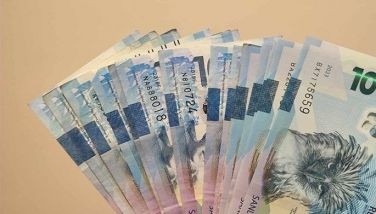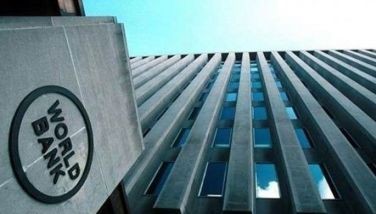GIR improves slightly to $16.18B as of April
May 8, 2003 | 12:00am
The Bangko Sentral ng Pilipinas (BSP) reported yesterday that the country’s gross international reserves (GIR) improved slightly to $16.18 billion as of end-April 2003 from $16.145 billion as of end-march 2003 as remittances from overseas Filipino workers brought in more dollars into the country.
The GIR represents the country’s total holdings of foreign currencies including special drawing rights (SDRs).
According to acting BSP governor Amando Tetangco, the GIR’s improvement in attributable to foreign exchange inflows as well as a slight increase in interest income and the revaluation of the country’s gold reserves.
The BSP said the current GIR level is comfortable and enough to cover 4.8 months worth of imported goods and payment of services and income.
Tetangco said that at $16.18 billion, the GIR is equivalent to over 2.6 times the country’s short-term debt based on original maturity or over 1.3 times based on residual maturity.
Short-term debt based on residual maturity refers to principal payments of public and private sectors that are due within the next 12 months. This means that the current level of GIR is enough to meet these short-term obligations, indicating no shortage of dollars to cause default.
The government spends considerable amounts of foreign currency on debt servicing but in April, this was offset by forex inflows, interest income and gold revaluation.
The end-April GIR also included the $585 million term loan facility of the BSP which was scheduled for disbursement last month. The BSP also had an $85 million windfall from the greenshoe option of the term loan.
The term-loan was arranged for the BSP by a group of banks led by HSBC as a coordinating arranger. The other arrangers were Citibank NA/Salomon Smith Barney Hongkong Ltd for $35 million; Credit Lyonnais for $32 million; the International Commercial Bank of China for $70 million, Sumitomo Mitsui Banking Corp for $33 million; Tokyo Mitsubishi International Ltd for $33 million and Mizuho Corporate Asia for $30 million.
Tetangco said the facility has a five-year tenor with an average life of three years and carried an interest margin of 2.33 percent per anum over US$ LIBOR. He said there is an option to allow lenders to convert their participation into floating rate notes one time only after the first six months from the drawdown date.
The proceeds of the loan, Tetangco said, would be used to repay an existing term loan facility of the BSP that is scheduled to mature in April 2003. He said the facility also has a greenshoe option to allow more banks to join under general syndication.
Tetangco revealed that this greenshoe option was capped at another $200 million on top of the first $500 million although the BSP was only able to get $85 million.
The GIR represents the country’s total holdings of foreign currencies including special drawing rights (SDRs).
According to acting BSP governor Amando Tetangco, the GIR’s improvement in attributable to foreign exchange inflows as well as a slight increase in interest income and the revaluation of the country’s gold reserves.
The BSP said the current GIR level is comfortable and enough to cover 4.8 months worth of imported goods and payment of services and income.
Tetangco said that at $16.18 billion, the GIR is equivalent to over 2.6 times the country’s short-term debt based on original maturity or over 1.3 times based on residual maturity.
Short-term debt based on residual maturity refers to principal payments of public and private sectors that are due within the next 12 months. This means that the current level of GIR is enough to meet these short-term obligations, indicating no shortage of dollars to cause default.
The government spends considerable amounts of foreign currency on debt servicing but in April, this was offset by forex inflows, interest income and gold revaluation.
The end-April GIR also included the $585 million term loan facility of the BSP which was scheduled for disbursement last month. The BSP also had an $85 million windfall from the greenshoe option of the term loan.
The term-loan was arranged for the BSP by a group of banks led by HSBC as a coordinating arranger. The other arrangers were Citibank NA/Salomon Smith Barney Hongkong Ltd for $35 million; Credit Lyonnais for $32 million; the International Commercial Bank of China for $70 million, Sumitomo Mitsui Banking Corp for $33 million; Tokyo Mitsubishi International Ltd for $33 million and Mizuho Corporate Asia for $30 million.
Tetangco said the facility has a five-year tenor with an average life of three years and carried an interest margin of 2.33 percent per anum over US$ LIBOR. He said there is an option to allow lenders to convert their participation into floating rate notes one time only after the first six months from the drawdown date.
The proceeds of the loan, Tetangco said, would be used to repay an existing term loan facility of the BSP that is scheduled to mature in April 2003. He said the facility also has a greenshoe option to allow more banks to join under general syndication.
Tetangco revealed that this greenshoe option was capped at another $200 million on top of the first $500 million although the BSP was only able to get $85 million.
BrandSpace Articles
<
>
- Latest
- Trending
Trending
Latest























